Strategic Analysis and Recommendations: Celanese Corporation Report
VerifiedAdded on 2019/10/16
|83
|18843
|418
Report
AI Summary
This comprehensive final report analyzes Celanese Corporation, a global technology and specialty materials company. The report begins with a company history and background, followed by an in-depth external analysis, examining the general environment, industry dynamics, and competitive landscape. This includes a five forces analysis to assess the industry's attractiveness. The internal analysis delves into Celanese's organizational structure, resources, capabilities, value chain, and financial performance, including valuation, profitability, financial strength, and management efficiency. A SWOT analysis synthesizes the findings, leading to specific strategic recommendations and implementation plans, including action plans, goals, and risk assessment. The report aims to provide a thorough understanding of Celanese's market position and strategic options for future growth, while also looking at how the company fits in the chemical manufacturing industry.
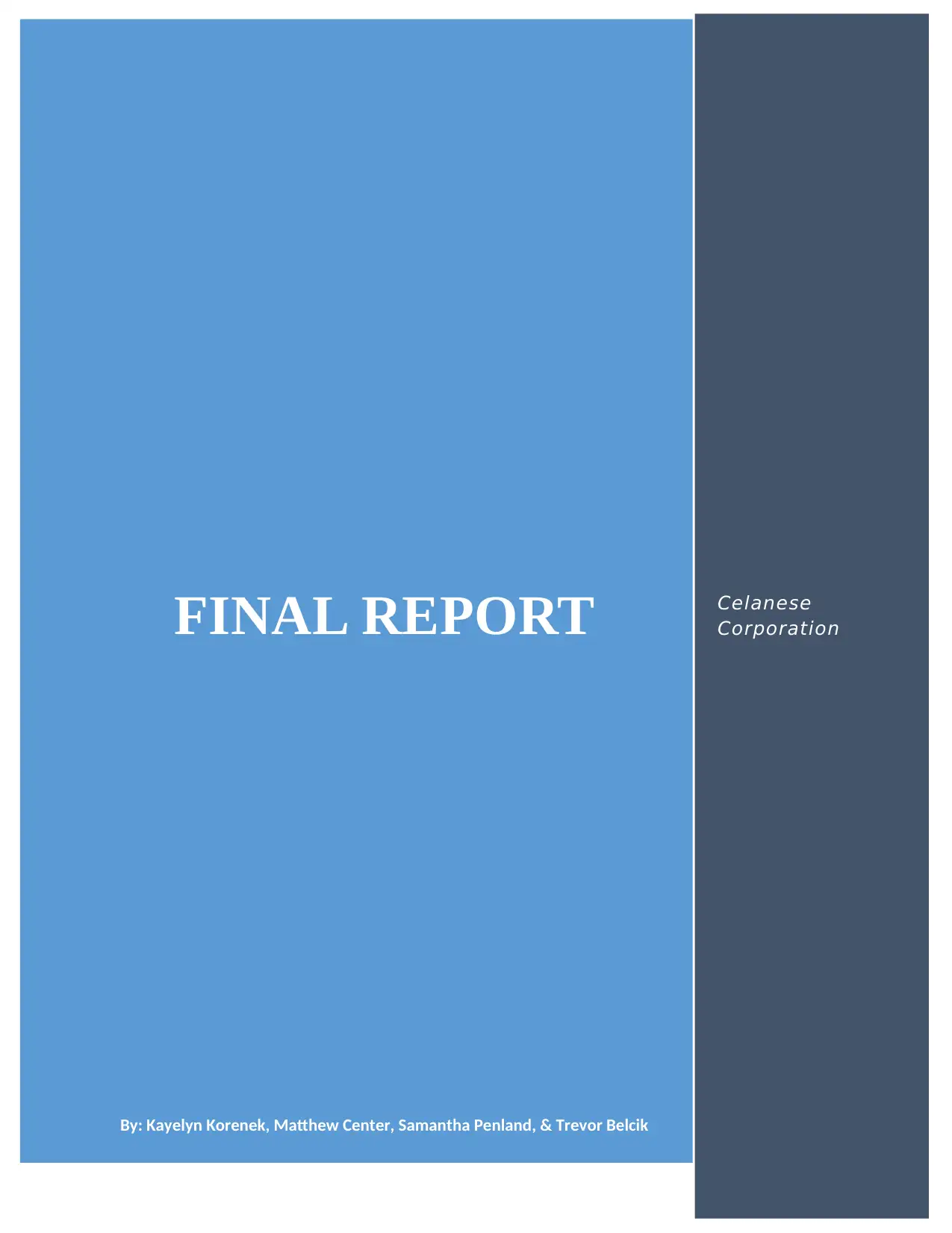
0
FINAL REPORT
By: Kayelyn Korenek, Matthew Center, Samantha Penland, & Trevor Belcik
Celanese
Corporation
FINAL REPORT
By: Kayelyn Korenek, Matthew Center, Samantha Penland, & Trevor Belcik
Celanese
Corporation
Paraphrase This Document
Need a fresh take? Get an instant paraphrase of this document with our AI Paraphraser
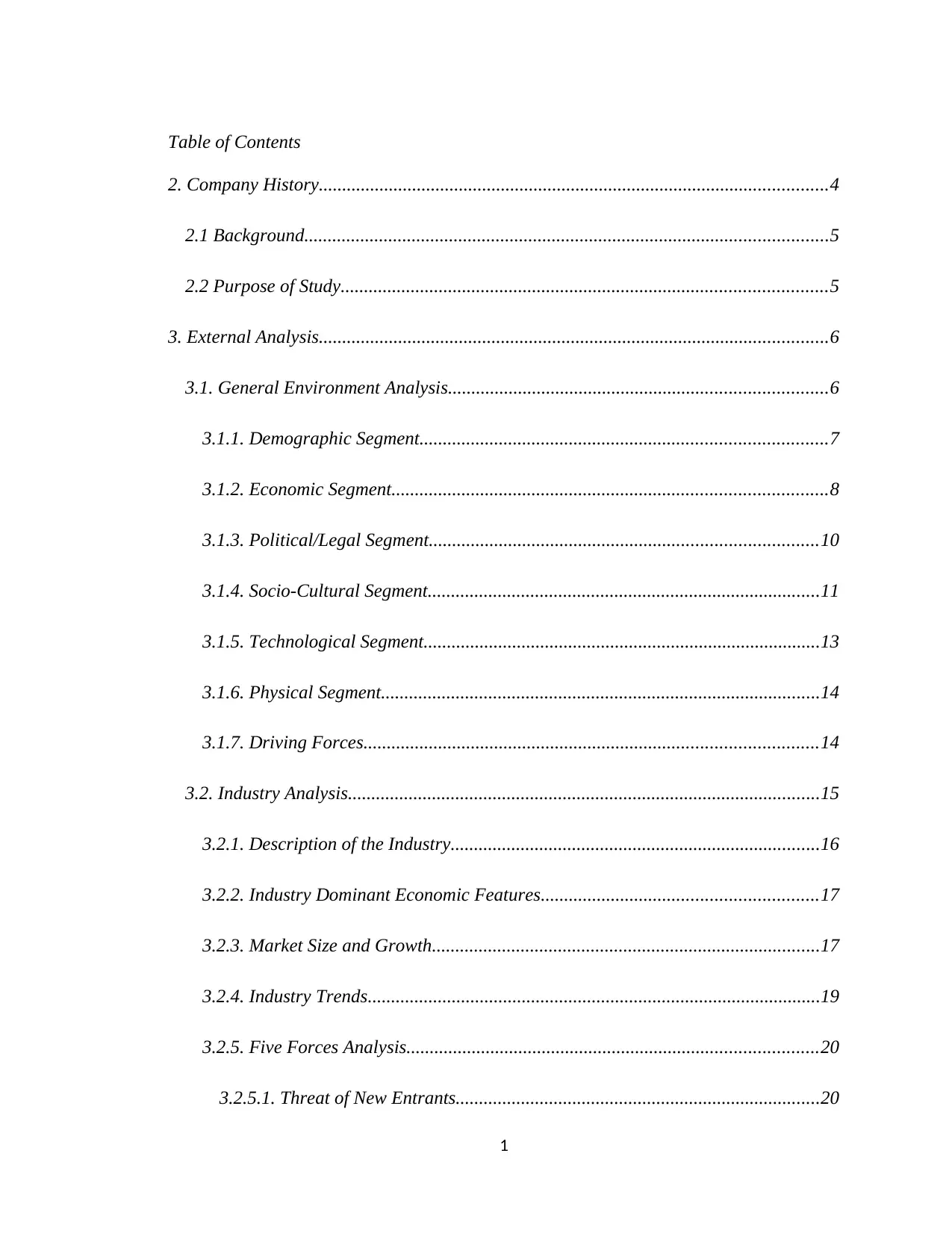
Table of Contents
2. Company History.............................................................................................................4
2.1 Background................................................................................................................5
2.2 Purpose of Study........................................................................................................5
3. External Analysis.............................................................................................................6
3.1. General Environment Analysis.................................................................................6
3.1.1. Demographic Segment.......................................................................................7
3.1.2. Economic Segment.............................................................................................8
3.1.3. Political/Legal Segment...................................................................................10
3.1.4. Socio-Cultural Segment....................................................................................11
3.1.5. Technological Segment.....................................................................................13
3.1.6. Physical Segment..............................................................................................14
3.1.7. Driving Forces.................................................................................................14
3.2. Industry Analysis.....................................................................................................15
3.2.1. Description of the Industry...............................................................................16
3.2.2. Industry Dominant Economic Features...........................................................17
3.2.3. Market Size and Growth...................................................................................17
3.2.4. Industry Trends.................................................................................................19
3.2.5. Five Forces Analysis........................................................................................20
3.2.5.1. Threat of New Entrants..............................................................................20
1
2. Company History.............................................................................................................4
2.1 Background................................................................................................................5
2.2 Purpose of Study........................................................................................................5
3. External Analysis.............................................................................................................6
3.1. General Environment Analysis.................................................................................6
3.1.1. Demographic Segment.......................................................................................7
3.1.2. Economic Segment.............................................................................................8
3.1.3. Political/Legal Segment...................................................................................10
3.1.4. Socio-Cultural Segment....................................................................................11
3.1.5. Technological Segment.....................................................................................13
3.1.6. Physical Segment..............................................................................................14
3.1.7. Driving Forces.................................................................................................14
3.2. Industry Analysis.....................................................................................................15
3.2.1. Description of the Industry...............................................................................16
3.2.2. Industry Dominant Economic Features...........................................................17
3.2.3. Market Size and Growth...................................................................................17
3.2.4. Industry Trends.................................................................................................19
3.2.5. Five Forces Analysis........................................................................................20
3.2.5.1. Threat of New Entrants..............................................................................20
1
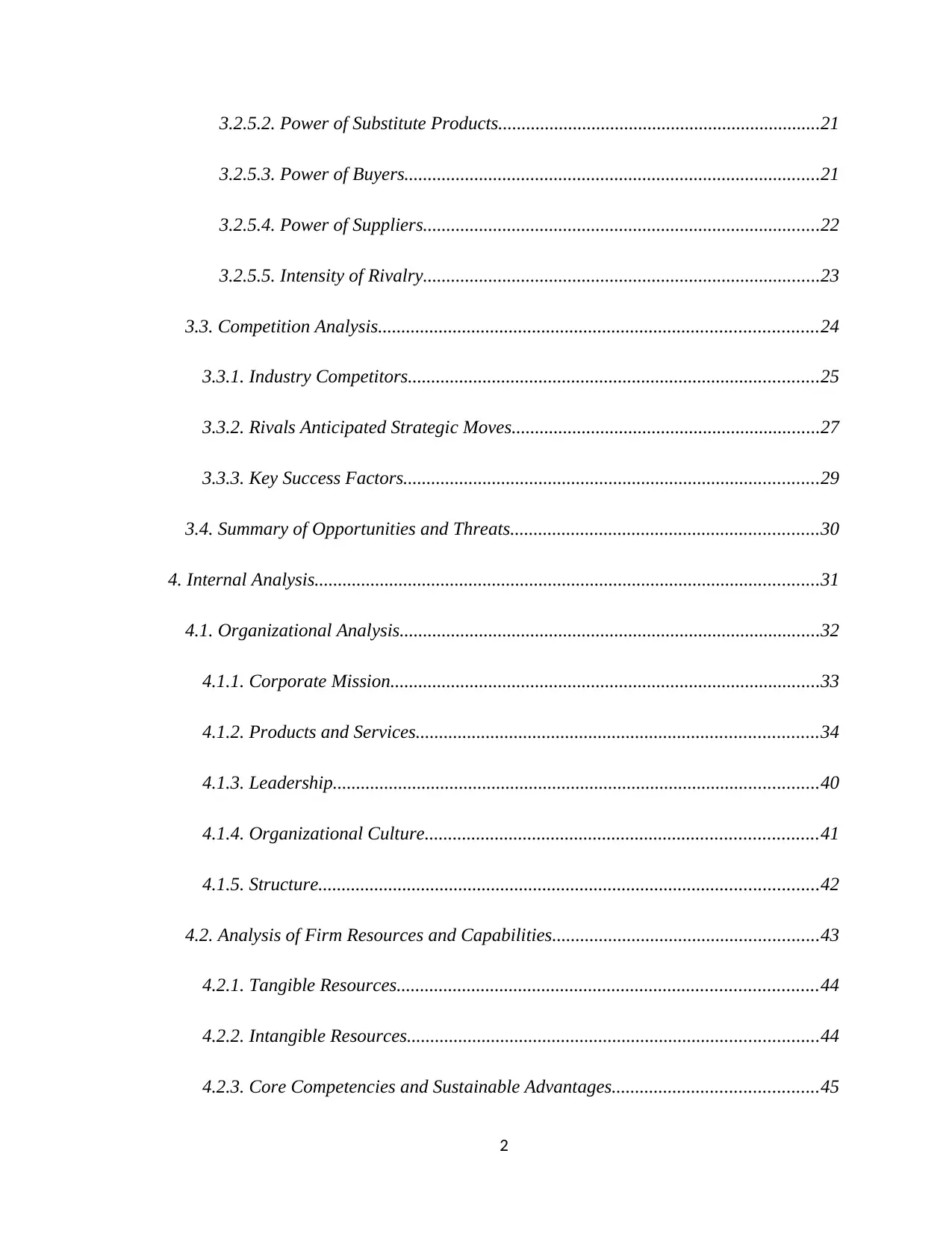
3.2.5.2. Power of Substitute Products.....................................................................21
3.2.5.3. Power of Buyers.........................................................................................21
3.2.5.4. Power of Suppliers.....................................................................................22
3.2.5.5. Intensity of Rivalry.....................................................................................23
3.3. Competition Analysis..............................................................................................24
3.3.1. Industry Competitors........................................................................................25
3.3.2. Rivals Anticipated Strategic Moves..................................................................27
3.3.3. Key Success Factors.........................................................................................29
3.4. Summary of Opportunities and Threats..................................................................30
4. Internal Analysis............................................................................................................31
4.1. Organizational Analysis..........................................................................................32
4.1.1. Corporate Mission............................................................................................33
4.1.2. Products and Services......................................................................................34
4.1.3. Leadership........................................................................................................40
4.1.4. Organizational Culture....................................................................................41
4.1.5. Structure...........................................................................................................42
4.2. Analysis of Firm Resources and Capabilities.........................................................43
4.2.1. Tangible Resources..........................................................................................44
4.2.2. Intangible Resources........................................................................................44
4.2.3. Core Competencies and Sustainable Advantages............................................45
2
3.2.5.3. Power of Buyers.........................................................................................21
3.2.5.4. Power of Suppliers.....................................................................................22
3.2.5.5. Intensity of Rivalry.....................................................................................23
3.3. Competition Analysis..............................................................................................24
3.3.1. Industry Competitors........................................................................................25
3.3.2. Rivals Anticipated Strategic Moves..................................................................27
3.3.3. Key Success Factors.........................................................................................29
3.4. Summary of Opportunities and Threats..................................................................30
4. Internal Analysis............................................................................................................31
4.1. Organizational Analysis..........................................................................................32
4.1.1. Corporate Mission............................................................................................33
4.1.2. Products and Services......................................................................................34
4.1.3. Leadership........................................................................................................40
4.1.4. Organizational Culture....................................................................................41
4.1.5. Structure...........................................................................................................42
4.2. Analysis of Firm Resources and Capabilities.........................................................43
4.2.1. Tangible Resources..........................................................................................44
4.2.2. Intangible Resources........................................................................................44
4.2.3. Core Competencies and Sustainable Advantages............................................45
2
⊘ This is a preview!⊘
Do you want full access?
Subscribe today to unlock all pages.

Trusted by 1+ million students worldwide
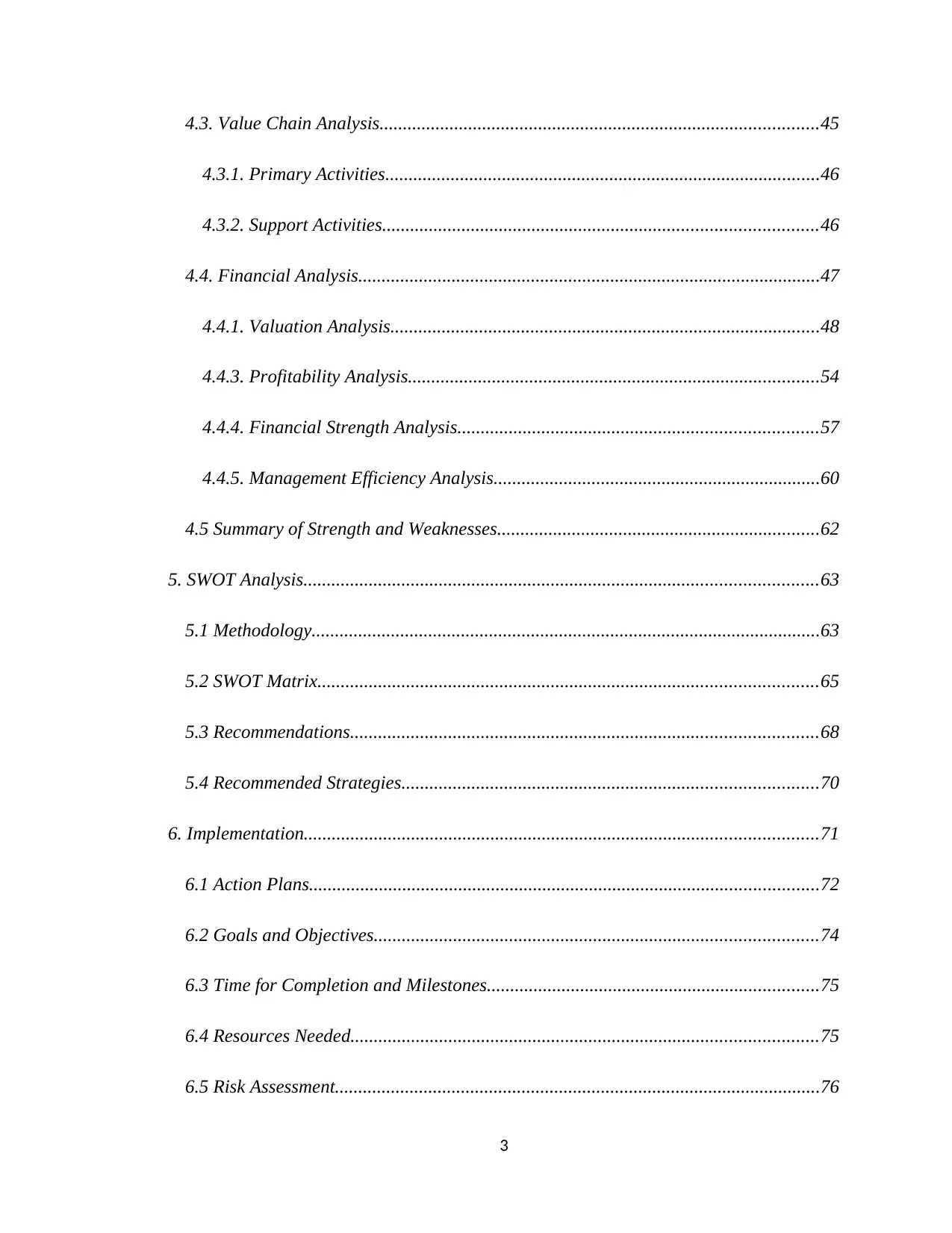
4.3. Value Chain Analysis..............................................................................................45
4.3.1. Primary Activities.............................................................................................46
4.3.2. Support Activities.............................................................................................46
4.4. Financial Analysis...................................................................................................47
4.4.1. Valuation Analysis............................................................................................48
4.4.3. Profitability Analysis........................................................................................54
4.4.4. Financial Strength Analysis.............................................................................57
4.4.5. Management Efficiency Analysis......................................................................60
4.5 Summary of Strength and Weaknesses.....................................................................62
5. SWOT Analysis..............................................................................................................63
5.1 Methodology.............................................................................................................63
5.2 SWOT Matrix...........................................................................................................65
5.3 Recommendations....................................................................................................68
5.4 Recommended Strategies.........................................................................................70
6. Implementation..............................................................................................................71
6.1 Action Plans.............................................................................................................72
6.2 Goals and Objectives...............................................................................................74
6.3 Time for Completion and Milestones.......................................................................75
6.4 Resources Needed....................................................................................................75
6.5 Risk Assessment........................................................................................................76
3
4.3.1. Primary Activities.............................................................................................46
4.3.2. Support Activities.............................................................................................46
4.4. Financial Analysis...................................................................................................47
4.4.1. Valuation Analysis............................................................................................48
4.4.3. Profitability Analysis........................................................................................54
4.4.4. Financial Strength Analysis.............................................................................57
4.4.5. Management Efficiency Analysis......................................................................60
4.5 Summary of Strength and Weaknesses.....................................................................62
5. SWOT Analysis..............................................................................................................63
5.1 Methodology.............................................................................................................63
5.2 SWOT Matrix...........................................................................................................65
5.3 Recommendations....................................................................................................68
5.4 Recommended Strategies.........................................................................................70
6. Implementation..............................................................................................................71
6.1 Action Plans.............................................................................................................72
6.2 Goals and Objectives...............................................................................................74
6.3 Time for Completion and Milestones.......................................................................75
6.4 Resources Needed....................................................................................................75
6.5 Risk Assessment........................................................................................................76
3
Paraphrase This Document
Need a fresh take? Get an instant paraphrase of this document with our AI Paraphraser
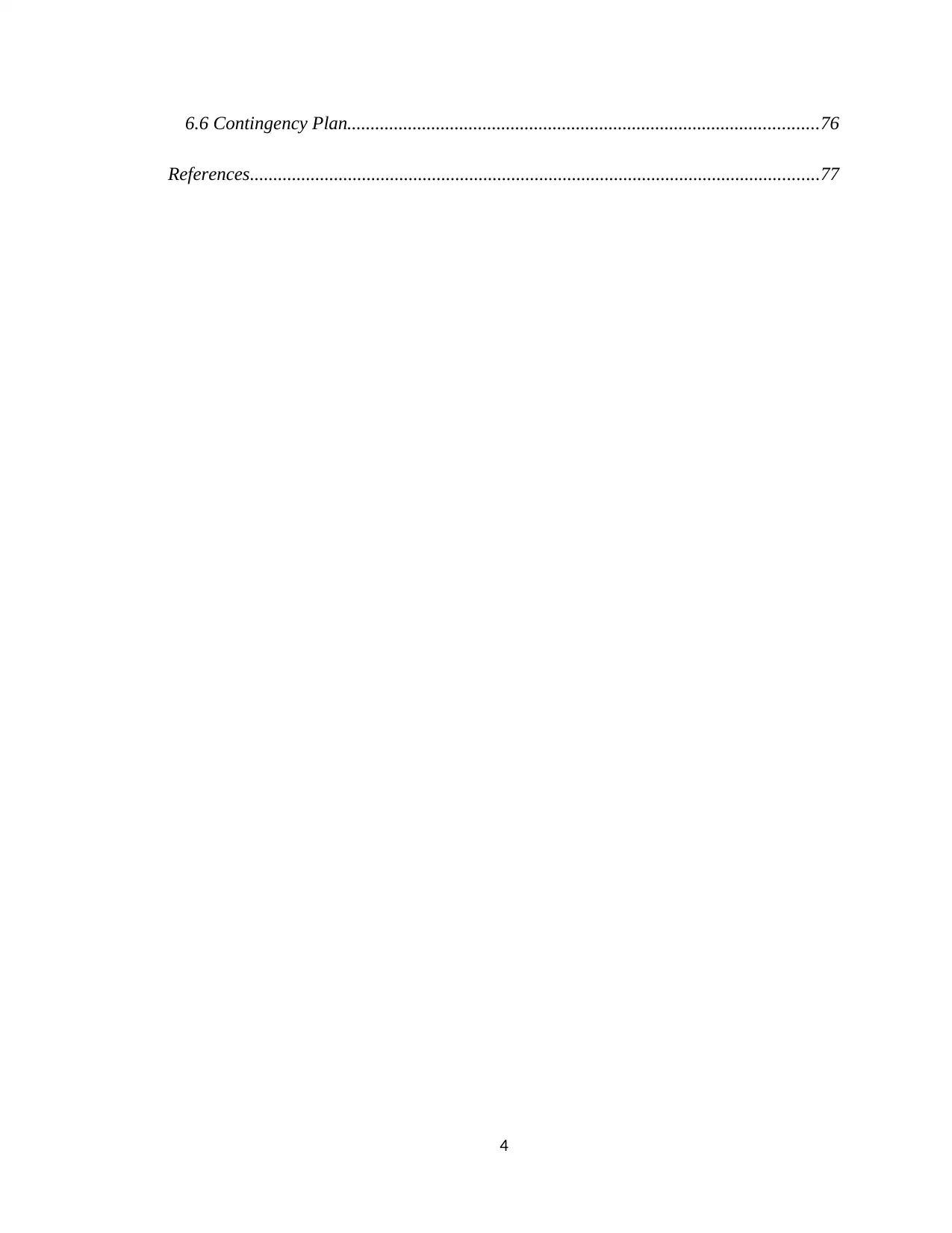
6.6 Contingency Plan.....................................................................................................76
References..........................................................................................................................77
4
References..........................................................................................................................77
4
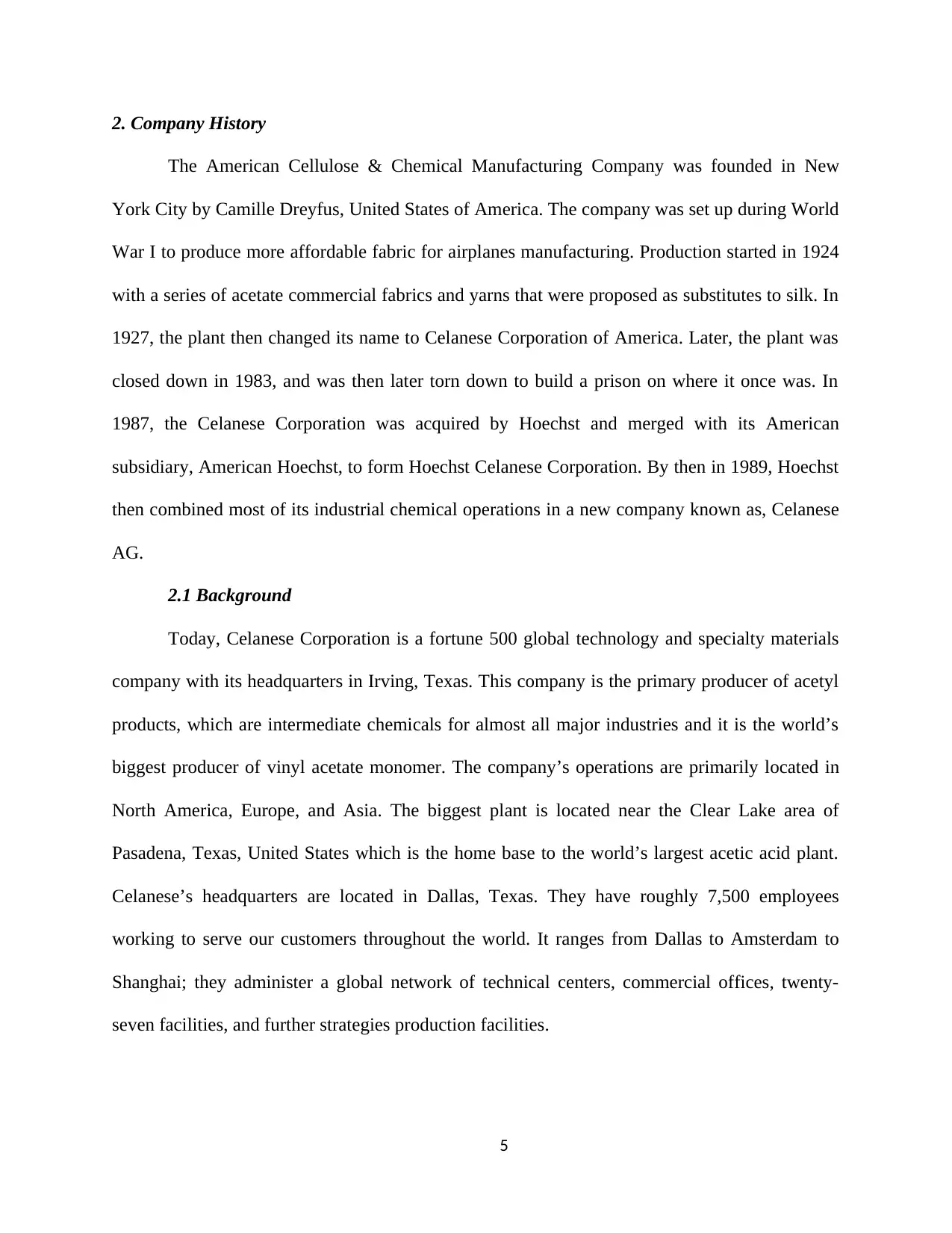
2. Company History
The American Cellulose & Chemical Manufacturing Company was founded in New
York City by Camille Dreyfus, United States of America. The company was set up during World
War I to produce more affordable fabric for airplanes manufacturing. Production started in 1924
with a series of acetate commercial fabrics and yarns that were proposed as substitutes to silk. In
1927, the plant then changed its name to Celanese Corporation of America. Later, the plant was
closed down in 1983, and was then later torn down to build a prison on where it once was. In
1987, the Celanese Corporation was acquired by Hoechst and merged with its American
subsidiary, American Hoechst, to form Hoechst Celanese Corporation. By then in 1989, Hoechst
then combined most of its industrial chemical operations in a new company known as, Celanese
AG.
2.1 Background
Today, Celanese Corporation is a fortune 500 global technology and specialty materials
company with its headquarters in Irving, Texas. This company is the primary producer of acetyl
products, which are intermediate chemicals for almost all major industries and it is the world’s
biggest producer of vinyl acetate monomer. The company’s operations are primarily located in
North America, Europe, and Asia. The biggest plant is located near the Clear Lake area of
Pasadena, Texas, United States which is the home base to the world’s largest acetic acid plant.
Celanese’s headquarters are located in Dallas, Texas. They have roughly 7,500 employees
working to serve our customers throughout the world. It ranges from Dallas to Amsterdam to
Shanghai; they administer a global network of technical centers, commercial offices, twenty-
seven facilities, and further strategies production facilities.
5
The American Cellulose & Chemical Manufacturing Company was founded in New
York City by Camille Dreyfus, United States of America. The company was set up during World
War I to produce more affordable fabric for airplanes manufacturing. Production started in 1924
with a series of acetate commercial fabrics and yarns that were proposed as substitutes to silk. In
1927, the plant then changed its name to Celanese Corporation of America. Later, the plant was
closed down in 1983, and was then later torn down to build a prison on where it once was. In
1987, the Celanese Corporation was acquired by Hoechst and merged with its American
subsidiary, American Hoechst, to form Hoechst Celanese Corporation. By then in 1989, Hoechst
then combined most of its industrial chemical operations in a new company known as, Celanese
AG.
2.1 Background
Today, Celanese Corporation is a fortune 500 global technology and specialty materials
company with its headquarters in Irving, Texas. This company is the primary producer of acetyl
products, which are intermediate chemicals for almost all major industries and it is the world’s
biggest producer of vinyl acetate monomer. The company’s operations are primarily located in
North America, Europe, and Asia. The biggest plant is located near the Clear Lake area of
Pasadena, Texas, United States which is the home base to the world’s largest acetic acid plant.
Celanese’s headquarters are located in Dallas, Texas. They have roughly 7,500 employees
working to serve our customers throughout the world. It ranges from Dallas to Amsterdam to
Shanghai; they administer a global network of technical centers, commercial offices, twenty-
seven facilities, and further strategies production facilities.
5
⊘ This is a preview!⊘
Do you want full access?
Subscribe today to unlock all pages.

Trusted by 1+ million students worldwide
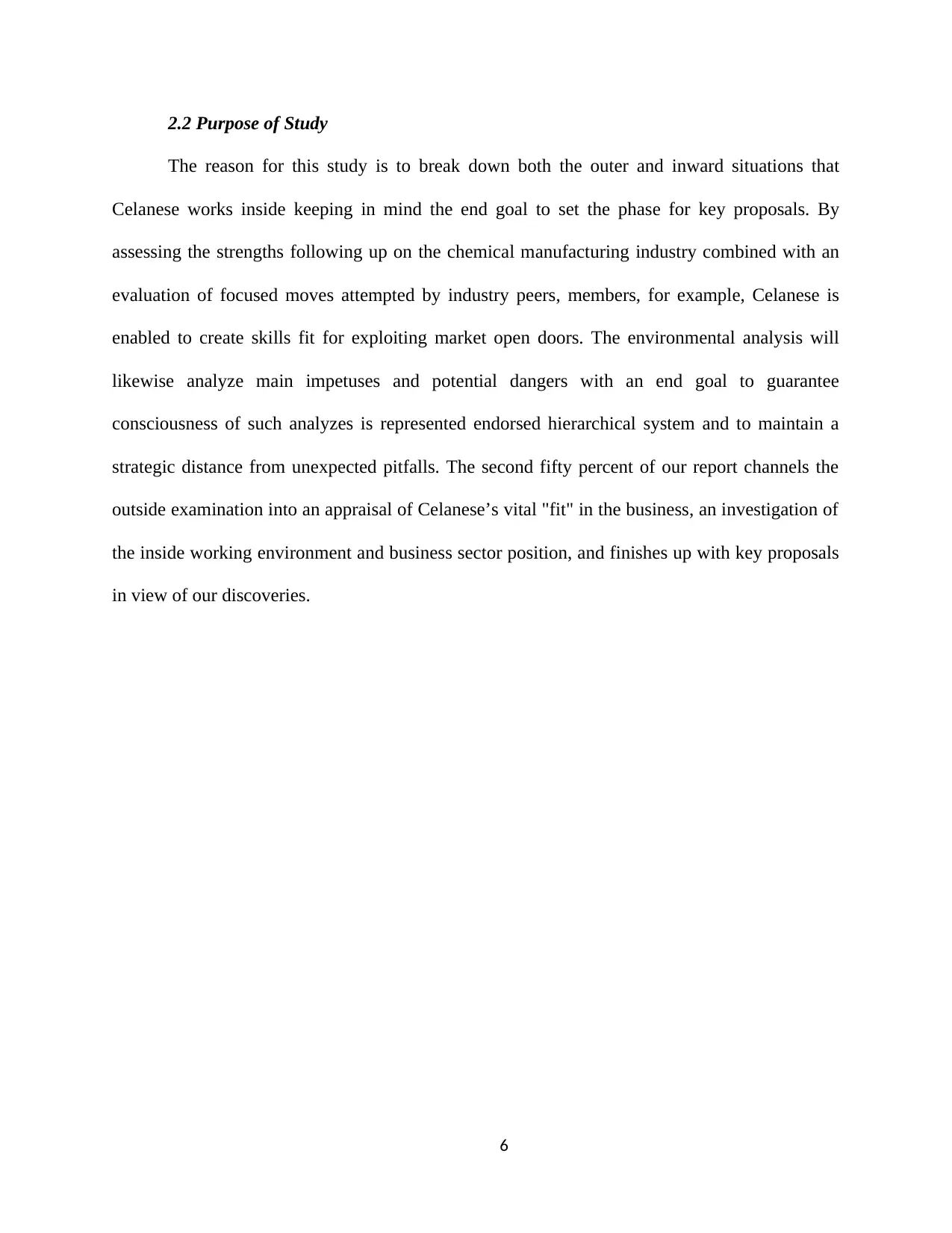
2.2 Purpose of Study
The reason for this study is to break down both the outer and inward situations that
Celanese works inside keeping in mind the end goal to set the phase for key proposals. By
assessing the strengths following up on the chemical manufacturing industry combined with an
evaluation of focused moves attempted by industry peers, members, for example, Celanese is
enabled to create skills fit for exploiting market open doors. The environmental analysis will
likewise analyze main impetuses and potential dangers with an end goal to guarantee
consciousness of such analyzes is represented endorsed hierarchical system and to maintain a
strategic distance from unexpected pitfalls. The second fifty percent of our report channels the
outside examination into an appraisal of Celanese’s vital "fit" in the business, an investigation of
the inside working environment and business sector position, and finishes up with key proposals
in view of our discoveries.
6
The reason for this study is to break down both the outer and inward situations that
Celanese works inside keeping in mind the end goal to set the phase for key proposals. By
assessing the strengths following up on the chemical manufacturing industry combined with an
evaluation of focused moves attempted by industry peers, members, for example, Celanese is
enabled to create skills fit for exploiting market open doors. The environmental analysis will
likewise analyze main impetuses and potential dangers with an end goal to guarantee
consciousness of such analyzes is represented endorsed hierarchical system and to maintain a
strategic distance from unexpected pitfalls. The second fifty percent of our report channels the
outside examination into an appraisal of Celanese’s vital "fit" in the business, an investigation of
the inside working environment and business sector position, and finishes up with key proposals
in view of our discoveries.
6
Paraphrase This Document
Need a fresh take? Get an instant paraphrase of this document with our AI Paraphraser
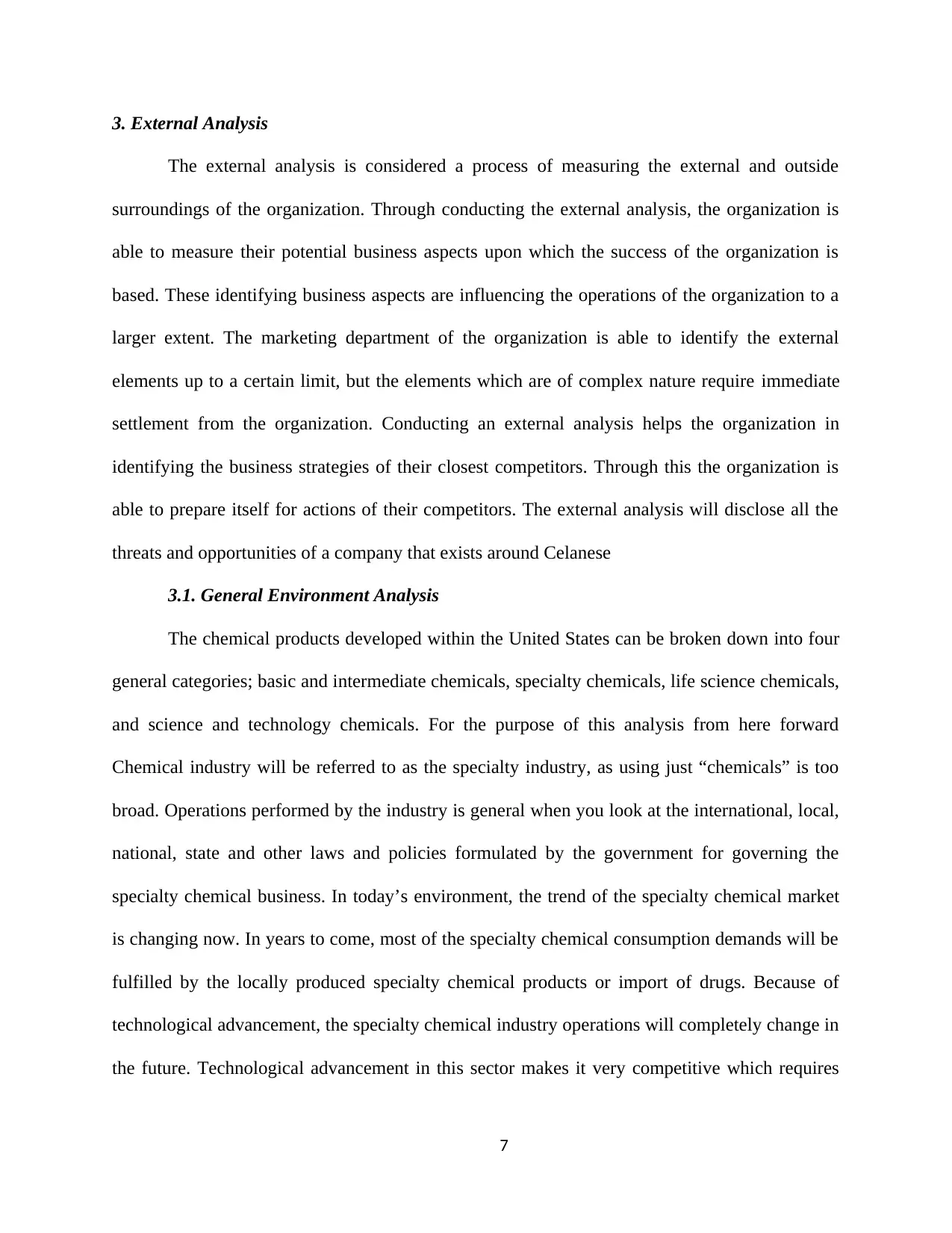
3. External Analysis
The external analysis is considered a process of measuring the external and outside
surroundings of the organization. Through conducting the external analysis, the organization is
able to measure their potential business aspects upon which the success of the organization is
based. These identifying business aspects are influencing the operations of the organization to a
larger extent. The marketing department of the organization is able to identify the external
elements up to a certain limit, but the elements which are of complex nature require immediate
settlement from the organization. Conducting an external analysis helps the organization in
identifying the business strategies of their closest competitors. Through this the organization is
able to prepare itself for actions of their competitors. The external analysis will disclose all the
threats and opportunities of a company that exists around Celanese
3.1. General Environment Analysis
The chemical products developed within the United States can be broken down into four
general categories; basic and intermediate chemicals, specialty chemicals, life science chemicals,
and science and technology chemicals. For the purpose of this analysis from here forward
Chemical industry will be referred to as the specialty industry, as using just “chemicals” is too
broad. Operations performed by the industry is general when you look at the international, local,
national, state and other laws and policies formulated by the government for governing the
specialty chemical business. In today’s environment, the trend of the specialty chemical market
is changing now. In years to come, most of the specialty chemical consumption demands will be
fulfilled by the locally produced specialty chemical products or import of drugs. Because of
technological advancement, the specialty chemical industry operations will completely change in
the future. Technological advancement in this sector makes it very competitive which requires
7
The external analysis is considered a process of measuring the external and outside
surroundings of the organization. Through conducting the external analysis, the organization is
able to measure their potential business aspects upon which the success of the organization is
based. These identifying business aspects are influencing the operations of the organization to a
larger extent. The marketing department of the organization is able to identify the external
elements up to a certain limit, but the elements which are of complex nature require immediate
settlement from the organization. Conducting an external analysis helps the organization in
identifying the business strategies of their closest competitors. Through this the organization is
able to prepare itself for actions of their competitors. The external analysis will disclose all the
threats and opportunities of a company that exists around Celanese
3.1. General Environment Analysis
The chemical products developed within the United States can be broken down into four
general categories; basic and intermediate chemicals, specialty chemicals, life science chemicals,
and science and technology chemicals. For the purpose of this analysis from here forward
Chemical industry will be referred to as the specialty industry, as using just “chemicals” is too
broad. Operations performed by the industry is general when you look at the international, local,
national, state and other laws and policies formulated by the government for governing the
specialty chemical business. In today’s environment, the trend of the specialty chemical market
is changing now. In years to come, most of the specialty chemical consumption demands will be
fulfilled by the locally produced specialty chemical products or import of drugs. Because of
technological advancement, the specialty chemical industry operations will completely change in
the future. Technological advancement in this sector makes it very competitive which requires
7
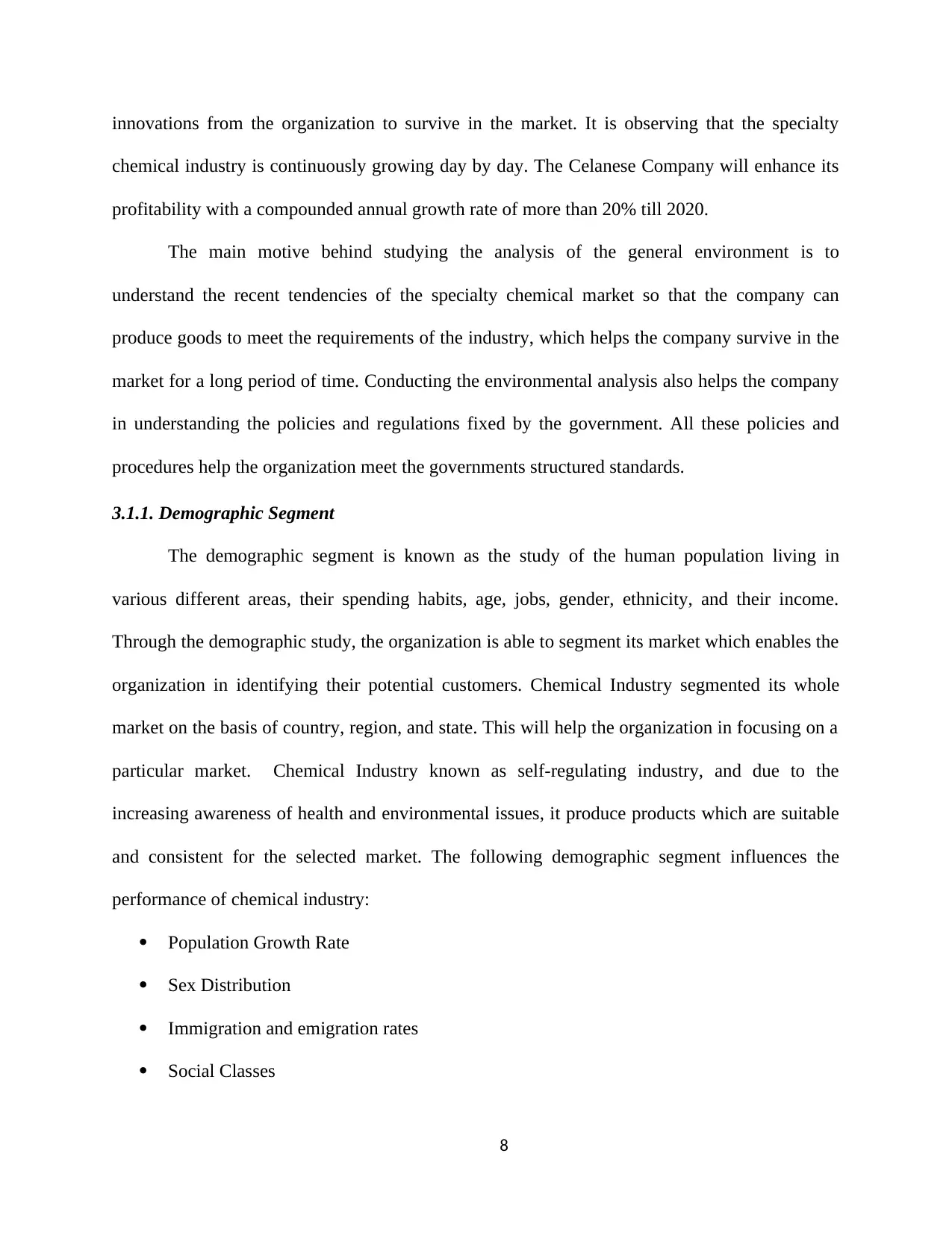
innovations from the organization to survive in the market. It is observing that the specialty
chemical industry is continuously growing day by day. The Celanese Company will enhance its
profitability with a compounded annual growth rate of more than 20% till 2020.
The main motive behind studying the analysis of the general environment is to
understand the recent tendencies of the specialty chemical market so that the company can
produce goods to meet the requirements of the industry, which helps the company survive in the
market for a long period of time. Conducting the environmental analysis also helps the company
in understanding the policies and regulations fixed by the government. All these policies and
procedures help the organization meet the governments structured standards.
3.1.1. Demographic Segment
The demographic segment is known as the study of the human population living in
various different areas, their spending habits, age, jobs, gender, ethnicity, and their income.
Through the demographic study, the organization is able to segment its market which enables the
organization in identifying their potential customers. Chemical Industry segmented its whole
market on the basis of country, region, and state. This will help the organization in focusing on a
particular market. Chemical Industry known as self-regulating industry, and due to the
increasing awareness of health and environmental issues, it produce products which are suitable
and consistent for the selected market. The following demographic segment influences the
performance of chemical industry:
Population Growth Rate
Sex Distribution
Immigration and emigration rates
Social Classes
8
chemical industry is continuously growing day by day. The Celanese Company will enhance its
profitability with a compounded annual growth rate of more than 20% till 2020.
The main motive behind studying the analysis of the general environment is to
understand the recent tendencies of the specialty chemical market so that the company can
produce goods to meet the requirements of the industry, which helps the company survive in the
market for a long period of time. Conducting the environmental analysis also helps the company
in understanding the policies and regulations fixed by the government. All these policies and
procedures help the organization meet the governments structured standards.
3.1.1. Demographic Segment
The demographic segment is known as the study of the human population living in
various different areas, their spending habits, age, jobs, gender, ethnicity, and their income.
Through the demographic study, the organization is able to segment its market which enables the
organization in identifying their potential customers. Chemical Industry segmented its whole
market on the basis of country, region, and state. This will help the organization in focusing on a
particular market. Chemical Industry known as self-regulating industry, and due to the
increasing awareness of health and environmental issues, it produce products which are suitable
and consistent for the selected market. The following demographic segment influences the
performance of chemical industry:
Population Growth Rate
Sex Distribution
Immigration and emigration rates
Social Classes
8
⊘ This is a preview!⊘
Do you want full access?
Subscribe today to unlock all pages.

Trusted by 1+ million students worldwide
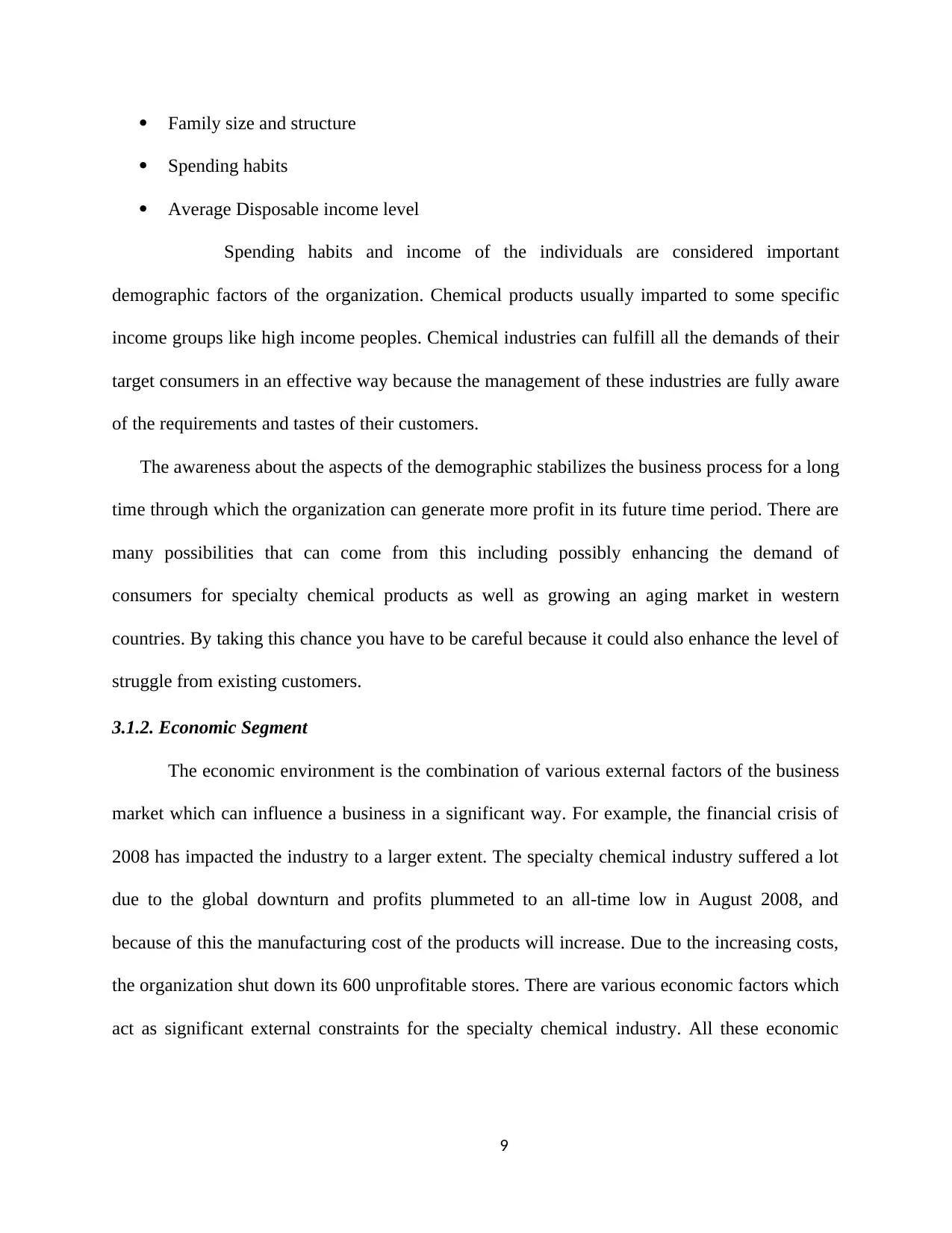
Family size and structure
Spending habits
Average Disposable income level
Spending habits and income of the individuals are considered important
demographic factors of the organization. Chemical products usually imparted to some specific
income groups like high income peoples. Chemical industries can fulfill all the demands of their
target consumers in an effective way because the management of these industries are fully aware
of the requirements and tastes of their customers.
The awareness about the aspects of the demographic stabilizes the business process for a long
time through which the organization can generate more profit in its future time period. There are
many possibilities that can come from this including possibly enhancing the demand of
consumers for specialty chemical products as well as growing an aging market in western
countries. By taking this chance you have to be careful because it could also enhance the level of
struggle from existing customers.
3.1.2. Economic Segment
The economic environment is the combination of various external factors of the business
market which can influence a business in a significant way. For example, the financial crisis of
2008 has impacted the industry to a larger extent. The specialty chemical industry suffered a lot
due to the global downturn and profits plummeted to an all-time low in August 2008, and
because of this the manufacturing cost of the products will increase. Due to the increasing costs,
the organization shut down its 600 unprofitable stores. There are various economic factors which
act as significant external constraints for the specialty chemical industry. All these economic
9
Spending habits
Average Disposable income level
Spending habits and income of the individuals are considered important
demographic factors of the organization. Chemical products usually imparted to some specific
income groups like high income peoples. Chemical industries can fulfill all the demands of their
target consumers in an effective way because the management of these industries are fully aware
of the requirements and tastes of their customers.
The awareness about the aspects of the demographic stabilizes the business process for a long
time through which the organization can generate more profit in its future time period. There are
many possibilities that can come from this including possibly enhancing the demand of
consumers for specialty chemical products as well as growing an aging market in western
countries. By taking this chance you have to be careful because it could also enhance the level of
struggle from existing customers.
3.1.2. Economic Segment
The economic environment is the combination of various external factors of the business
market which can influence a business in a significant way. For example, the financial crisis of
2008 has impacted the industry to a larger extent. The specialty chemical industry suffered a lot
due to the global downturn and profits plummeted to an all-time low in August 2008, and
because of this the manufacturing cost of the products will increase. Due to the increasing costs,
the organization shut down its 600 unprofitable stores. There are various economic factors which
act as significant external constraints for the specialty chemical industry. All these economic
9
Paraphrase This Document
Need a fresh take? Get an instant paraphrase of this document with our AI Paraphraser
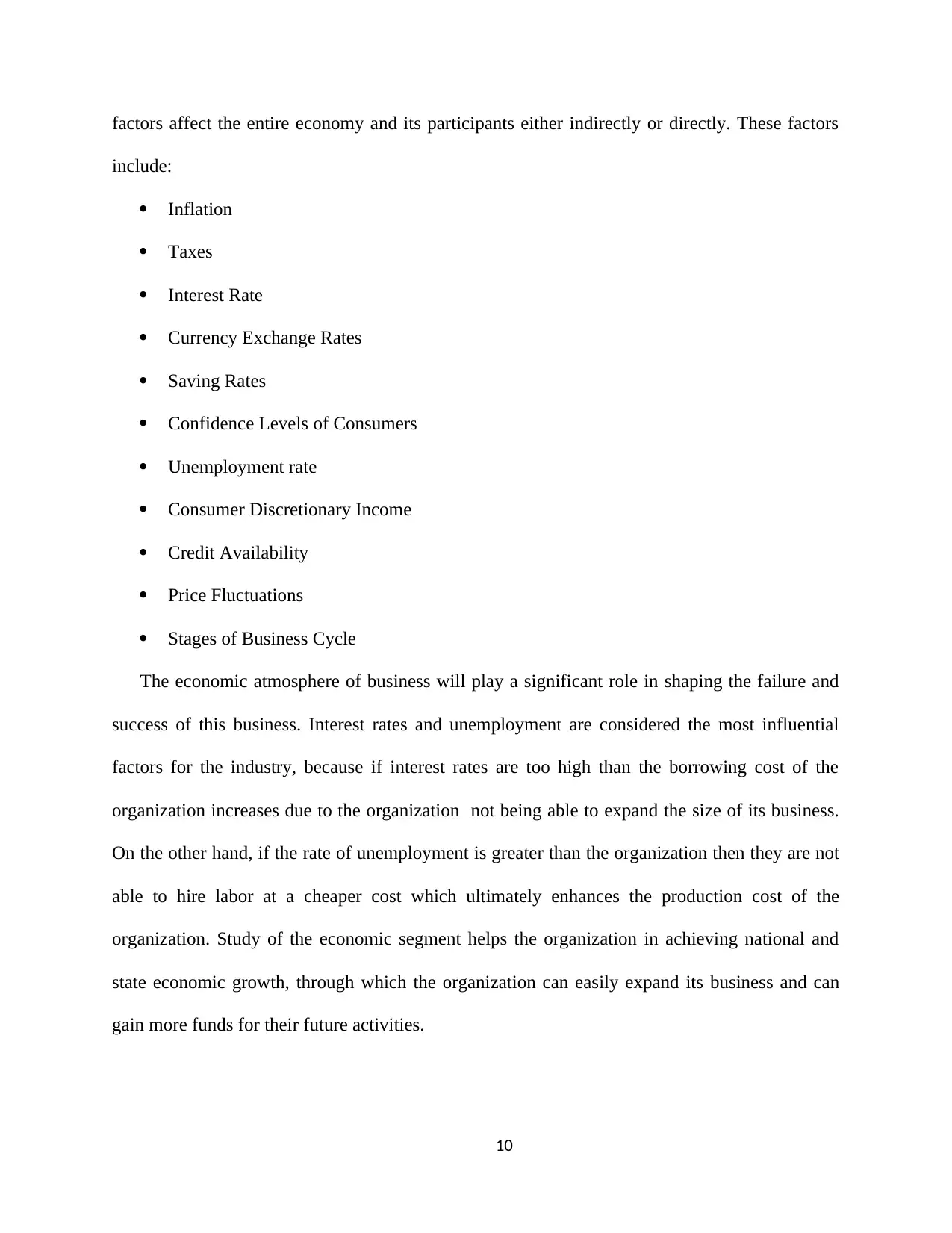
factors affect the entire economy and its participants either indirectly or directly. These factors
include:
Inflation
Taxes
Interest Rate
Currency Exchange Rates
Saving Rates
Confidence Levels of Consumers
Unemployment rate
Consumer Discretionary Income
Credit Availability
Price Fluctuations
Stages of Business Cycle
The economic atmosphere of business will play a significant role in shaping the failure and
success of this business. Interest rates and unemployment are considered the most influential
factors for the industry, because if interest rates are too high than the borrowing cost of the
organization increases due to the organization not being able to expand the size of its business.
On the other hand, if the rate of unemployment is greater than the organization then they are not
able to hire labor at a cheaper cost which ultimately enhances the production cost of the
organization. Study of the economic segment helps the organization in achieving national and
state economic growth, through which the organization can easily expand its business and can
gain more funds for their future activities.
10
include:
Inflation
Taxes
Interest Rate
Currency Exchange Rates
Saving Rates
Confidence Levels of Consumers
Unemployment rate
Consumer Discretionary Income
Credit Availability
Price Fluctuations
Stages of Business Cycle
The economic atmosphere of business will play a significant role in shaping the failure and
success of this business. Interest rates and unemployment are considered the most influential
factors for the industry, because if interest rates are too high than the borrowing cost of the
organization increases due to the organization not being able to expand the size of its business.
On the other hand, if the rate of unemployment is greater than the organization then they are not
able to hire labor at a cheaper cost which ultimately enhances the production cost of the
organization. Study of the economic segment helps the organization in achieving national and
state economic growth, through which the organization can easily expand its business and can
gain more funds for their future activities.
10
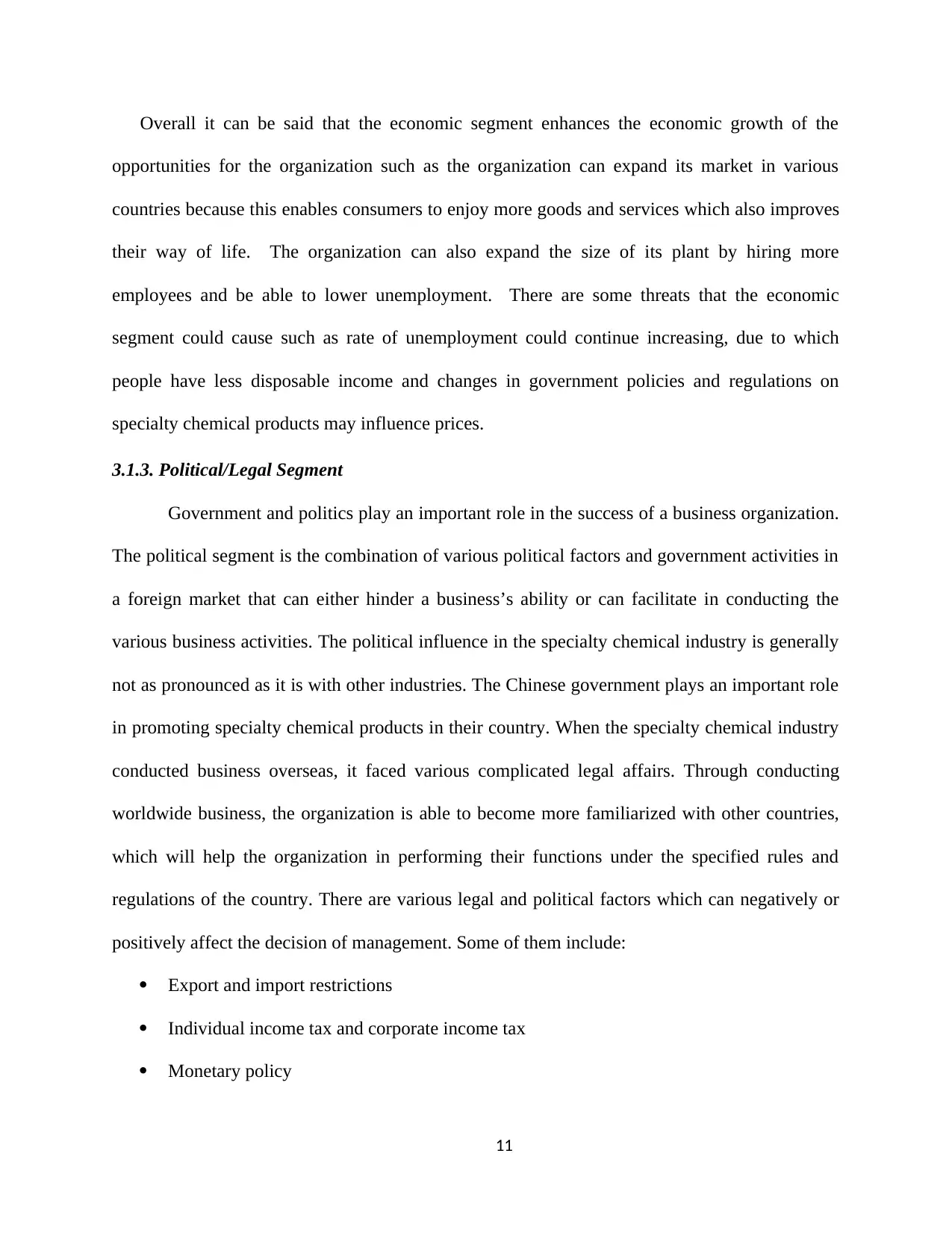
Overall it can be said that the economic segment enhances the economic growth of the
opportunities for the organization such as the organization can expand its market in various
countries because this enables consumers to enjoy more goods and services which also improves
their way of life. The organization can also expand the size of its plant by hiring more
employees and be able to lower unemployment. There are some threats that the economic
segment could cause such as rate of unemployment could continue increasing, due to which
people have less disposable income and changes in government policies and regulations on
specialty chemical products may influence prices.
3.1.3. Political/Legal Segment
Government and politics play an important role in the success of a business organization.
The political segment is the combination of various political factors and government activities in
a foreign market that can either hinder a business’s ability or can facilitate in conducting the
various business activities. The political influence in the specialty chemical industry is generally
not as pronounced as it is with other industries. The Chinese government plays an important role
in promoting specialty chemical products in their country. When the specialty chemical industry
conducted business overseas, it faced various complicated legal affairs. Through conducting
worldwide business, the organization is able to become more familiarized with other countries,
which will help the organization in performing their functions under the specified rules and
regulations of the country. There are various legal and political factors which can negatively or
positively affect the decision of management. Some of them include:
Export and import restrictions
Individual income tax and corporate income tax
Monetary policy
11
opportunities for the organization such as the organization can expand its market in various
countries because this enables consumers to enjoy more goods and services which also improves
their way of life. The organization can also expand the size of its plant by hiring more
employees and be able to lower unemployment. There are some threats that the economic
segment could cause such as rate of unemployment could continue increasing, due to which
people have less disposable income and changes in government policies and regulations on
specialty chemical products may influence prices.
3.1.3. Political/Legal Segment
Government and politics play an important role in the success of a business organization.
The political segment is the combination of various political factors and government activities in
a foreign market that can either hinder a business’s ability or can facilitate in conducting the
various business activities. The political influence in the specialty chemical industry is generally
not as pronounced as it is with other industries. The Chinese government plays an important role
in promoting specialty chemical products in their country. When the specialty chemical industry
conducted business overseas, it faced various complicated legal affairs. Through conducting
worldwide business, the organization is able to become more familiarized with other countries,
which will help the organization in performing their functions under the specified rules and
regulations of the country. There are various legal and political factors which can negatively or
positively affect the decision of management. Some of them include:
Export and import restrictions
Individual income tax and corporate income tax
Monetary policy
11
⊘ This is a preview!⊘
Do you want full access?
Subscribe today to unlock all pages.

Trusted by 1+ million students worldwide
1 out of 83
Your All-in-One AI-Powered Toolkit for Academic Success.
+13062052269
info@desklib.com
Available 24*7 on WhatsApp / Email
![[object Object]](/_next/static/media/star-bottom.7253800d.svg)
Unlock your academic potential
Copyright © 2020–2025 A2Z Services. All Rights Reserved. Developed and managed by ZUCOL.
